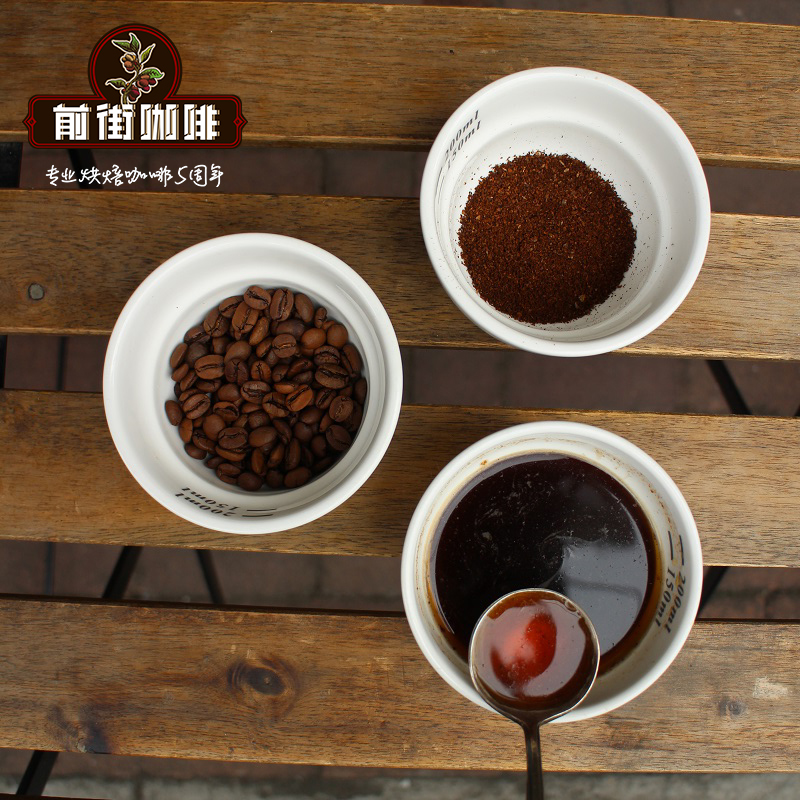How are coffee beans baked? How many categories are there in roasting coffee beans? Coffee beans are roasted

Professional coffee knowledge exchange more coffee bean information please follow the coffee workshop (Wechat official account cafe_style)
How are coffee beans baked? How many categories are there in roasting coffee beans?
1. Definition of baking
The so-called coffee roasting (coffee roasting) refers to the process that through heating the raw beans, a series of physical and chemical reactions take place inside and outside of the coffee beans, and in this process, the sour, bitter, sweet and other flavors of the coffee are formed, forming mellowness and hue, and transforming the raw beans into dark brown beans.
2. The importance of baking
Among the factors affecting the taste of a cup of coffee, raw beans account for 60%, roasting accounts for 30%, and extraction accounts for 10%. Good roasting can maximize the personality of raw beans and minimize the occurrence of defective flavors. on the contrary, improper roasting will completely destroy good beans. As the heating, time, and temperature control in the baking process is very difficult to grasp, baking technology is a very complex technology, so the importance of baking is more prominent.
Baking degree
From the point of view of the baking degree, the deeper the baking degree, the stronger the bitter taste; the lighter the baking degree, the stronger the sour taste. The choice of baking degree depends on the characteristics of the coffee bean itself. for coffee beans with strong bitterness and light sour taste, they generally choose a moderate and shallow roasting degree.
1. Shallow baking (Light)
The most mild fried culture, no fragrance and concentration to speak of, the beans are not yet ripe, with the green taste of raw beans, not suitable for grinding and drinking. It's usually used as an experiment.
(photo: Nestle Coffee China)
2. Deep shallow baking (Cinnamon)
Also known as cinnamon baking, for the general popular degree of frying, leaving a strong sour taste. The color of beans is quite similar to that of cinnamon, so it is also called cinnamon baking and its sour taste is aggravated. It is favored by people in the western United States.
3. Shallow medium baking (Media)
The color deepens, easy to extract the original taste of coffee beans, mellow, sour and delicious.
4. Medium baking (High)
Coffee has a stronger flavor and a lighter sour taste, which is the general roasting method of coffee beans. The sour taste is neutralized and bitter, suitable for coffee such as Blue Mountain and Kilimanjaro. It is loved by Japanese and Nordic people.
(photo: Nestle Coffee China)
5. Deep medium baking (City)
Also known as city baking, bitter taste is stronger than sour taste, almost no sour taste, unique flavor. Coffee suitable for Colombia and Brazil is very popular in New York.
6. Normal baking (Full City)
Also known as city-wide baking, suitable for brewing iced coffee. No sour taste, mainly bitter taste, bitterness will be aggravated, but high-quality beans will have sweet taste. It is used for iced coffee and is preferred by people in Central and South America.
7. French baking (French)
French baking method, slightly black color, strong bitterness, but also ooze oil, bitterness and concentration are deepened. Coffee used for steam pressurizer.
8. Deep baking (Italian)
Also known as Italian baking, the deepest baking degree, the beans are black and bright, the surface is oozing oil, the bitterness is very strong. At this stage, coffee beans have been seriously carbonized, and it is difficult to distinguish the taste of one kind of coffee bean from another. For Italian steam pressurized coffee
Factors of coffee color change:
Coffee beans are light green and turn brown when roasted. This baking characteristic brown mainly comes from the brown pigment produced by oligosaccharins, amino acids and chlorogenic acids. The so-called brown pigment does not refer to a color or ingredient, but a general term for the many ingredients that make coffee different colors.
The color of raw beans changes gradually during baking because of the change in the total amount of brown pigment and the proportion of its molecular size. Brown pigments can be classified according to molecular size. Shallow baking will mostly produce small molecular pigments. With the deeper the baking degree, the total amount of pigments will gradually increase, and the proportion of macromolecular pigments will also increase.
Light baked beans mostly contain small yellowish pigments, which are chemical reaction products in the early stage of baking and substances produced by the reaction between oligosaccharides and chlorogenic acids.
If you continue baking, the oligosaccharides will be caramelized to produce caramel pigments. Coupled with the molasses pigment (Melanoidin) produced by the reaction of oligosaccharides with amino acids, a slightly larger reddish brown pigment occurs. The reaction produced by molasses pigment is called Mena browning reaction (Maillard reactions), which is a very important kind of food chemical reaction. The color and flavor of toast and the color of soy sauce are all the result of Mena's browning reaction.
If you continue to bake, proteins and polysaccharides are also added to turn into a black-brown pigment with more than a hundred times the size of the molecule.
This pigment is actually one of the elements that make up the bitterness of coffee. It is generally believed that the larger the molecule of the pigment, the stronger the bitterness of the coffee and the heavier the taste. Therefore, the intensity and taste of bitterness will change with the degree of roasting of coffee, which is affected by these pigment changes.
What are the taste characteristics of light-roasted, medium-roasted and deep-roasted coffee beans?
Generally shallow beans will be more light and refreshing flavor, and the flavor performance is very rich, flower fruit acid some tea taste is the flavor performance of this kind of beans. On the other hand, medium baking is a more balanced expression with both refreshing flavor and thick taste. Deep-baked beans are more similar to his taste, and their flavors are usually strong, such as smoke, chocolate and woody flavor. And it will be accompanied by a thick taste.
The classification of these three baking methods is only a very general method. In fact, the baking depth is affected by many factors, such as the style of the bean baker. This answer is only a general statement. The barista will adjust the baking curve according to the characteristics of each bean, and the flavor of the pot will be different by one degree or two seconds.
Baking process
1. Drying
When the raw bean is heated, the water vapor in the raw bean will evaporate, and the raw bean will turn white from green at about 135 degrees Celsius.
two。 dehydration
As the heating goes on, the raw beans change from green to light yellow, and when the temperature reaches about 160 degrees, the aroma of baked grain will be emitted. After continuous heating, the beans turn light brown.
3. An explosion
After about 190 degrees dehydration is completed, a burst occurs due to the rupture of the cell wall caused by internal thermal expansion, and a series of thermal decomposition reactions occur inside the beans, in which the caramelization brings the sweetness, dark brown and mellowness of the coffee beans. the explosion lasts about a minute and a half.
4. Second explosion
As the heating goes on, it enters the "second explosion", and a more violent reaction will take place inside the bean. And give off a lot of heat. With the end of the second explosion, the raw bean has basically turned black, the bean body has expanded to 1.5 times that of the original, the surface is oily, and the weight is reduced to 12%, about 20%.
5. Stop it
Baking usually ends about a minute after the second explosion, when the temperature reaches 200 degrees, which is a deep French or Italian baking, which may cause the coffee beans to ignite spontaneously when the temperature exceeds 230 degrees Celsius.
Main roaster brands
1. Probat in Germany
Old brands, large and medium-sized machines, semi-automatic, full-automatic various types, sophisticated design, high price.
two。 Japan fuji-royal
The products of fuji Company of Japan also have good performance, but the same price is not cheap.
(3) brief introduction of Taiwan Yang family roaster
Yang family machine Pegasus brand coffee roaster, the classic model is stable and practical. The cast iron inner pot makes the boiler temperature stable, the heat accumulation is good, and the coffee beans are heated evenly. Taiwan's Yang family Pegasus machine boilers are all made of cast iron, and the thickness of the boiler wall is up to 12MM, which is very rare in China, the United States and Japan.
Important Notice :
前街咖啡 FrontStreet Coffee has moved to new addredd:
FrontStreet Coffee Address: 315,Donghua East Road,GuangZhou
Tel:020 38364473
- Prev

Flavor characteristics of Java coffee beans in Indonesia _ how much is Java java coffee beans _ where can I buy Java coffee beans
Professional coffee knowledge exchange more information about coffee beans please follow the coffee workshop (Wechat official account cafe_style) Indonesia, the country of the Thousand Islands, is the country with the largest number of islands in the world. When it comes to Indonesia, the most familiar is probably the resort island of Bali. Today, Xiao Le would like to introduce Java coffee in Indonesia. The wind of Indonesian coffee
- Next

Java Coffee Variety Mystery _ how about Indonesian Java Coffee Bean Brand recommendation
For more information on coffee beans, please follow the coffee workshop (Wechat official account cafe_style) Java Coffee is sometimes called Old Java. After the old government (the Old Government), Java Coffee was guaranteed to be at least ten years old in the tropics and has become a household name. Old Java coffee had a good reputation before 1915, and coffee beans were in transportation.
Related
- Detailed explanation of Jadeite planting Land in Panamanian Jadeite Manor introduction to the grading system of Jadeite competitive bidding, Red bid, Green bid and Rose Summer
- Story of Coffee planting in Brenka region of Costa Rica Stonehenge Manor anaerobic heavy honey treatment of flavor mouth
- What's on the barrel of Blue Mountain Coffee beans?
- Can American coffee also pull flowers? How to use hot American style to pull out a good-looking pattern?
- Can you make a cold extract with coffee beans? What is the right proportion for cold-extracted coffee formula?
- Indonesian PWN Gold Mandrine Coffee Origin Features Flavor How to Chong? Mandolin coffee is American.
- A brief introduction to the flavor characteristics of Brazilian yellow bourbon coffee beans
- What is the effect of different water quality on the flavor of cold-extracted coffee? What kind of water is best for brewing coffee?
- Why do you think of Rose Summer whenever you mention Panamanian coffee?
- Introduction to the characteristics of authentic blue mountain coffee bean producing areas? What is the CIB Coffee Authority in Jamaica?

